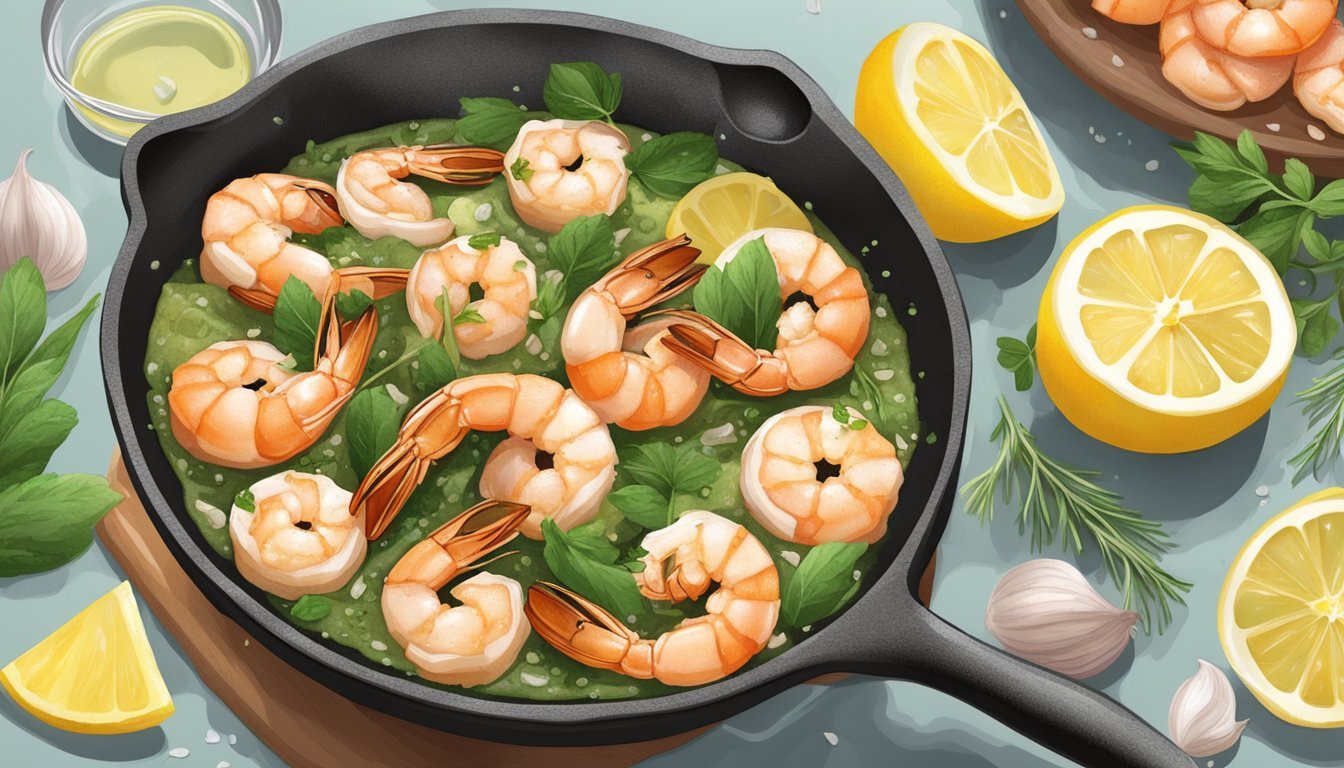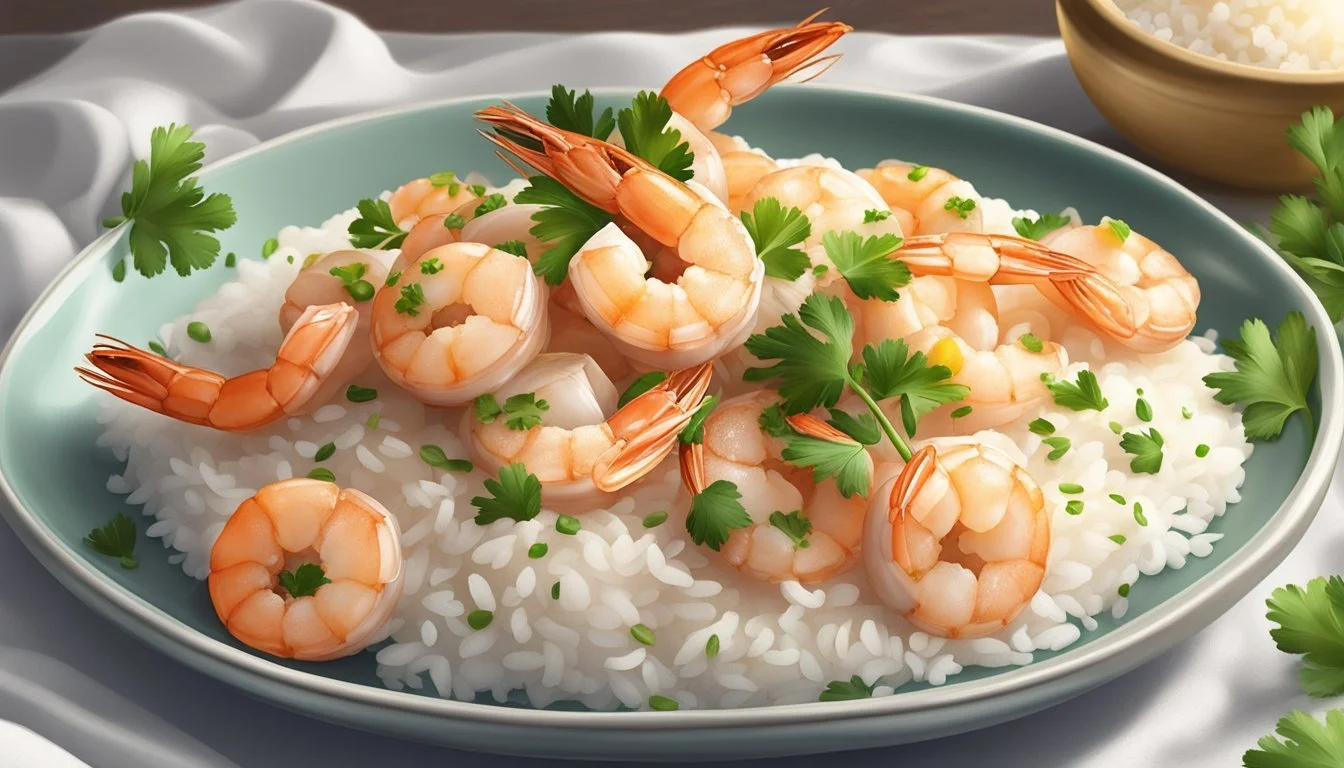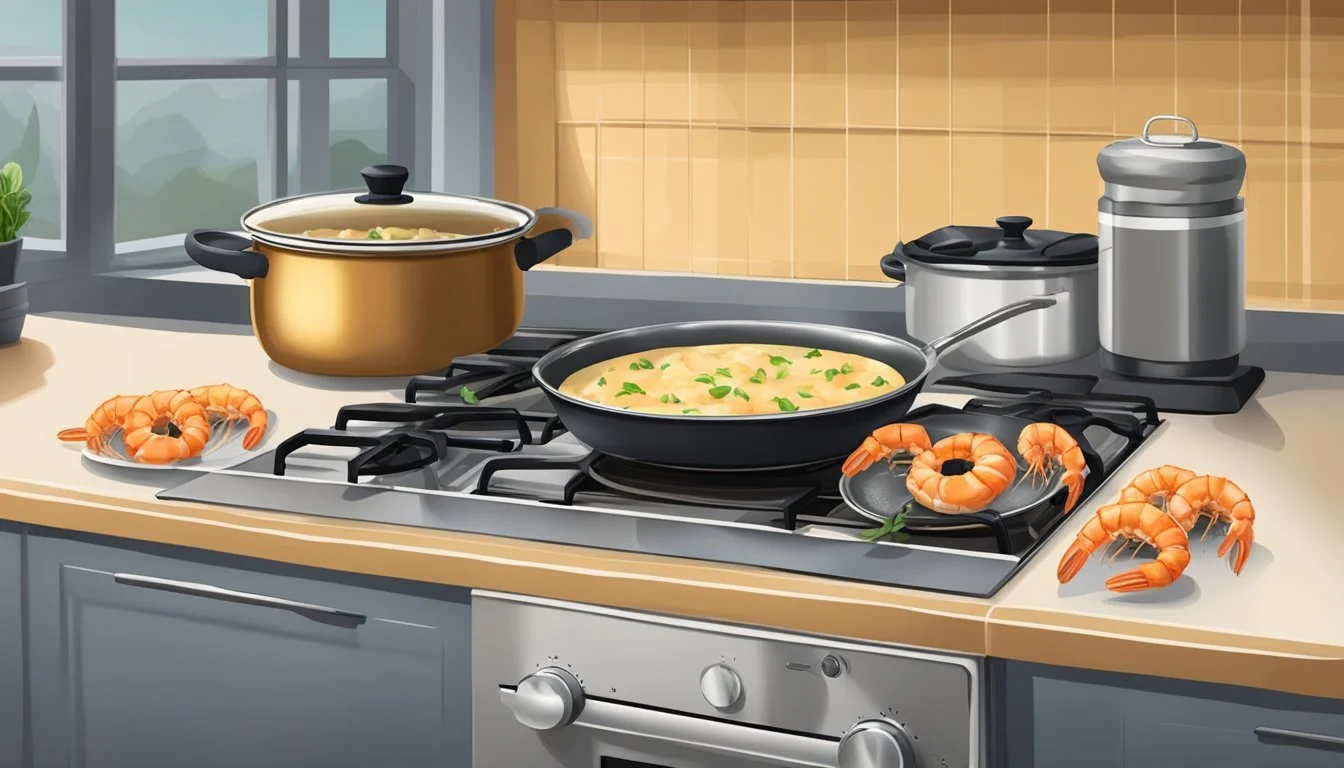How to Reheat Garlic Butter Shrimp
Easy and Effective Methods
Garlic butter shrimp are a delightful treat, but reheating them can be tricky since you don't want to lose that succulent texture and rich flavor. To reheat garlic butter shrimp while maintaining their delectable taste, use a skillet with a touch of butter and a splash of water or broth. This method locks in moisture and enhances flavors, ensuring your shrimp remain juicy and delicious.
For those who have gone the extra mile to prepare or purchase garlic butter shrimp, ensuring that these delicacies can be enjoyed as leftovers is crucial. Whether using a stovetop, microwave, or even a steamer, each method has its unique benefits to preserve the garlic and butter essence while reheating shrimp effectively.
It's important to note that not all reheating methods are equal. While the skillet approach is often favored, understanding the nuances of reheating garlic butter shrimp helps in making the best choice. This guide will walk you through the most effective techniques, offering tips to savor every bite of your shrimp leftovers.
Understanding Garlic Butter Shrimp
Garlic butter shrimp is a popular dish known for its rich, savory flavor, and quick preparation time. It combines the smoothness of butter with the intense taste of garlic, complemented by a touch of lemon juice and parsley for freshness.
Composition and Flavor Profile
Garlic butter shrimp consists of a few main ingredients that create its signature taste. These include butter, which imparts a creamy texture, and garlic, contributing a robust and aromatic flavor. Lemon juice adds a subtle tanginess, while parsley offers a hint of earthiness and color.
The shrimp itself is typically cooked until just done, ensuring it remains tender and succulent. The garlic butter sauce coats the shrimp, enhancing its natural sweetness. The balance of flavors makes this dish both simple and indulgent, appealing to seafood lovers and garlic enthusiasts alike.
Initial Preparation and Cooking
The preparation of garlic butter shrimp is straightforward. Start by melting butter in a large skillet over medium-high heat. Add the shrimp and cook briefly, usually 1-2 minutes per side, until they start to pink.
Next, garlic is added, cooking until it becomes fragrant. A splash of chicken broth or wine can be included to deepen the flavor, cooking for another 1-2 minutes. Finally, a touch of lemon juice and a sprinkle of parsley are added before serving to brighten the dish.
The prep time is minimal, often under 10 minutes, with a cooking time of about 5 minutes, making it a quick yet impressive dish. The process ensures that the shrimp remains juicy, and the flavors are well blended.
Storing Leftover Shrimp
Proper storage of leftover garlic butter shrimp ensures it remains safe to eat and retains its flavor. Whether refrigerating or freezing, following the best practices helps prevent bacterial growth and maintains quality.
Refrigeration Best Practices
To store leftover shrimp in the refrigerator, place the shrimp in an airtight container to minimize exposure to air. This reduces the risk of bacterial growth and helps retain moisture. It is important to store shrimp within two hours of cooking to ensure it remains safe for consumption.
Labeling the container with the date helps you track freshness. Leftover shrimp should be consumed within three days. Place the container on a shelf rather than the refrigerator door, as the temperature is more stable.
Freezing and Thawing Procedures
For longer storage, freezing is recommended. Lay the shrimp out on a baking sheet and place in the freezer until they are solid. Then transfer the shrimp to a heavy-duty freezer bag or airtight container. Label the bag with the date and contents.
When ready to use, thaw shrimp by placing them in the refrigerator overnight. For quicker thawing, place the sealed bag in a bowl of cold water. Change the water every 30 minutes to ensure even thawing. Once thawed, reheat shrimp as soon as possible to maintain quality.
Reheating Techniques
Reheating garlic butter shrimp correctly ensures they retain their flavor and texture. Each method—skillet, oven, and microwave—has distinct advantages and is best suited for specific situations.
Skillet Method
Reheating shrimp in a skillet is highly effective in preserving the buttery flavor and succulence. Start by melting butter or olive oil in a skillet over medium heat. Once the butter is melted, add the shrimp in a single layer.
Turn the shrimp to coat them evenly with the butter. Add a splash of water or broth to prevent drying out. Cover the skillet with a lid and heat for about 60-90 seconds until the shrimp are warmed through.
This method is quick and maintains the original flavors well, especially for dishes like garlic butter shrimp. Avoid overheating as it may make the shrimp rubbery.
Oven Approach
Using an oven to reheat shrimp is ideal for moderately larger batches. Preheat the oven to 300°F (150°C). Arrange the shrimp on a baking sheet in a single layer. To maintain moisture, add a small amount of butter or olive oil and cover the shrimp with foil.
Heat in the oven for about 10-15 minutes. Check periodically to ensure they don’t overcook. Adding a splash of broth or wine can also enhance the flavor during this process.
This method is beneficial for retaining the shrimp's texture and is great for a hands-off approach without much supervision, ensuring the reheating process is even.
Microwave Strategy
For convenience, reheating shrimp in a microwave works for small quantities. Place the shrimp in a microwave-safe dish and cover with a damp paper towel to retain moisture.
Heat on medium power for short bursts of 15-20 seconds, checking between each burst. This prevents overcooking. Add a touch of butter or broth before microwaving to ensure the shrimp remains juicy.
The microwave method is quick but requires careful monitoring to prevent the shrimp from becoming rubbery or over-dried. It’s best for when time is a constraint and other methods are not feasible.
Preserving Quality and Taste
Ensuring garlic butter shrimp retains its delectable flavor and succulent texture involves careful attention to moisture management and thoughtful use of seasonings.
Managing Moisture
Shrimp can easily dry out when reheated. To prevent this, maintain moisture by using a skillet with a lid. Start by melting butter or olive oil over medium heat. Add the shrimp and toss to coat evenly. Introduce a splash of water, broth, or wine to the pan to keep the shrimp moist.
Cover the skillet to trap steam, which helps retain the shrimp’s juiciness. Limit reheating time to 60-90 seconds for tender results. Overheating can lead to rubbery shrimp, so monitor closely.
Seasonings and Enhancements
Enhance the flavor by adding seasonings and fresh ingredients. Kosher salt and pepper are essential for basic seasoning. For a burst of freshness, incorporate lemon juice and fresh parsley at the end of reheating.
A pinch of red pepper flakes can introduce subtle heat, while additional garlic can amplify the garlic butter essence. Lightly season during and after reheating to preserve the delicate balance of flavors without overpowering the shrimp's natural sweetness.
Serving Suggestions
When serving reheated garlic butter shrimp, it's essential to pair it with complementary side dishes and explore creative serving ideas. These choices can elevate the shrimp from a simple dish to a memorable meal.
Complementary Side Dishes
Reheated garlic butter shrimp pairs well with rice such as herb-infused rice or garlic rice. These options soak up the delicious buttery sauce and enhance the meal. Pasta is another excellent choice; try pesto pasta or spaghetti aglio e olio for a balanced flavor profile.
For a lighter option, consider serving the shrimp with steamed vegetables like broccoli, asparagus, or green beans. These vegetables provide a fresh contrast.
If you prefer bread, crusty bread or focaccia can be perfect for sopping up the remaining sauce. Finally, a butter lettuce salad offers a refreshing, crisp side that doesn't overwhelm the shrimp.
Creative Serving Ideas
For a unique twist, consider transforming the reheated shrimp into a flavorful shrimp risotto. The creamy texture of the risotto complements the garlic butter flavor nicely. Another idea is to make shrimp tacos using soft tortillas, avocado, and a squeeze of lime for a fresh, zesty bite.
Shrimp can also be used in appetizers like shrimp salad or bang bang shrimp. Elevate your appetizer game by serving the shrimp atop mini bruschetta with a sprinkle of parmesan.
Lastly, create a surf-and-turf experience by pairing the shrimp with a grilled London broil steak. This combination adds a touch of sophistication to your meal.
Health and Safety Considerations
When reheating garlic butter shrimp, it is important to prioritize health and safety measures to prevent foodborne illnesses and ensure a tasty meal. Key considerations involve avoiding bacterial growth and ensuring proper handling and reheating techniques.
Avoiding Bacterial Growth
Ensuring shrimp are properly stored is critical. Leftover shrimp should be placed in the refrigerator within two hours of cooking, as room temperature can promote bacterial growth.
Store shrimp in airtight containers to minimize exposure to contaminants. The refrigerator temperature should be at or below 40°F (4°C). Avoiding multiple reheating cycles is vital because each reheating can expose the shrimp to the temperature danger zone (40°F - 140°F or 4°C - 60°C) where bacteria thrive.
Discard any shrimp left at room temperature for more than two hours. If storing for longer, freezing is a safer option, keeping shrimp edible for up to three months.
Proper Handling and Reheating
Proper handling involves cleanliness of utensils and work areas to prevent contamination. Always wash hands before touching shrimp.
For reheating, ensure the internal temperature of shrimp reaches 165°F (74°C) to kill any potential bacteria. Reheat using methods like a skillet, oven, or microwave, ensuring even heating. A hot water bath is effective, especially for maintaining the texture and flavor.
Use a food thermometer to check that shrimp has reached the safe internal temperature. Avoid overcooking to prevent rubbery texture. Proper reheating not only ensures safety but also retains the shrimp’s flavor and juiciness.
Alternative Uses for Leftover Garlic Butter Shrimp
Leftover garlic butter shrimp can be transformed into exciting new dishes. These are practical and delicious ways to make the most of your leftovers.
Transforming Leftovers into New Meals
Leftover garlic butter shrimp can easily become the star of a shrimp salad. Simply toss the shrimp with mixed greens, cherry tomatoes, cucumbers, and a light vinaigrette. This is both refreshing and uses minimal preparation.
For a warm option, consider adding the shrimp to zoodles (zucchini noodles). Heat the zoodles briefly, then toss them with the shrimp and a bit of extra garlic butter sauce. This creates a low-carb, flavorful meal that is quick to prepare.
Integrate the shrimp into shrimp scampi by adding them to cooked pasta. Heat the garlic butter shrimp in a skillet with some additional butter and lemon juice, then mix with the pasta. Top it with grated Parmesan cheese for an indulgent touch.
Creative Recipe Variations
Bang bang shrimp can be prepared by lightly coating the leftover shrimp in a tangy, spicy sauce. Typically, this sauce consists of mayonnaise, sweet chili sauce, and sriracha. Serve them as an appetizer or over a bed of rice for a heartier meal.
The shrimp can also be incorporated into a coconut shrimp curry. In a pot, combine coconut milk, curry paste, and vegetables of your choice. Add the shrimp last to prevent overcooking. This provides a rich, creamy dish that's perfect for colder days.
For a breakfast twist, use the shrimp in a shrimp omelette. Simply sauté some onions and bell peppers, then add the garlic butter shrimp and beaten eggs. Fold and cook until set. This is a unique and protein-packed way to start the day.







